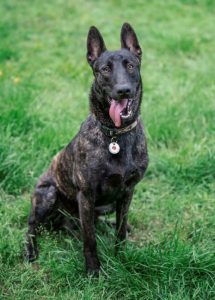 The History and Origin of the Dutch Shepherd
The History and Origin of the Dutch Shepherd
Many people often mistake the Dutch Shepherd (aka Herders), and the Belgian Shepherd since they share a very similar breed standard. The main differences are coat colour, size, and proportion requirements. Although the Dutch Shepherd’s origins are somewhat muddied, it is suggested that they descend from the same herding dogs that also created the Belgian Shepherd (aka Malinois) and the German Shepherd.
The Dutch Shepherd was originally bred in the early 1800s in the southern part of the Netherlands. The largest population of Dutch Shepherds was found in Brabant which bordered Belgium. The Dutch Shepherd’s original purpose was a farm dog, guard dog, cart dog, herder, security, or police dog. The Dutch Shepherd was virtually unheard of as a breed outside of Holland. In Holland, he is still valued as an excellent herding dog. When the first breed standard was written in 1898, the coat could be any colour, but in 1914, it was decided to allow only brindle to distinguish the breed from the then similar German Shepherd and Belgian Shepherd. The breeds eventually diverged into the six distinct breeds as they are known today, however, the Dutch Shepherd remains nearly the same dog it was more than 100 years ago; it is distinguished from the Belgian Shepherds and German Shepherd by the details specified in the breed standard, primarily of the head.
The number of Dutch Shepherds has decreased over the years. In the 1940s and 1950s, the Dutch Shepherd was almost extinct because modern farming reduced his need on the farm. During World War II all breeding was stopped in the Netherlands. Many dogs died from starvation or were taken into Germany for use in the German military. This caused many of the Dutch Shepherd bloodlines to become extinct. The Dutch Breed Club began actively trying to resurrect the Dutch Shepherd and added new blood to the gene pool by using the Malinois. After a time, the cross breeding was stopped by the Dutch Breed Club.
The Dutch Shepherd is still a rare breed. The UK Kennel Club officially recognised the Dutch Shepherd in 1995. In 2012, the American Kennel Club allowed the Dutch Shepherd to begin being recorded in its Foundation Stock Service.
An Overview of the Dutch Shepherd
The Dutch Shepherd is a herding dog of Dutch origin. They were used by shepherds and farmers who needed a versatile dog, with few demands, and a dog that was able to adapt to a harsh and meager existence. The Dutch Shepherd is a large, well-proportioned, well-muscled dog, with a powerful, well-balanced structure, an intelligent expression, and a lively temperament.
 Characteristics of the Dutch Shepherd
Characteristics of the Dutch Shepherd
Dutch Shepherds are known for their intelligence and all-around competency in just about everything, including agility, acting as watchdogs, search and rescue, herding, field training, police work, guide dog duty, and just being a family companion. They are highly trainable and eager to please, soaking up new commands like a sponge.
This breed requires a confident trainer who can set boundaries, keep dogs interested in learning, and build a trusting relationship. Early socialisation training is important and will help them stay calm around new people and pets. The Dutch Shepherd is an excellent watchdog and usually barks when a stranger enters their territory. This can be beneficial, but it is also important for dogs to learn to interact with guests appropriately.
Dutch Shepherds are great with family, even children and other pets, and they are very affectionate and obedient. They will, however, need plenty of exercise, both mentally and physically, to keep from becoming bored and destructive.
What kind of owner and household suit a Herder?
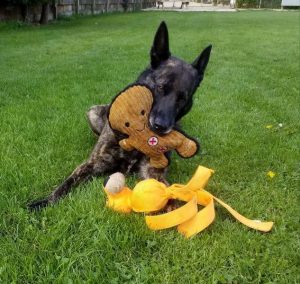 Dutch Shepherds have not changed much since their days on Netherlands farms over a century ago and is prized for its intelligence and its trainable nature. Today, they serve as police dogs, guides for the blind, obedience competition competitors, and family companions, and they still have not lost their ability to herd, though there is less demand for that in modern times. Dutch Shepherds make excellent family dogs that are great with kids and other pets, though they need an active environment that will keep them mentally and physically stimulated, or they may get bored and destructive. Early socialisation will help them keep calm around new pets and people. The Dutch Shepherd’s coat keeps them comfortable in both hot and cold weather, though their skin and coat will need some attention if they live in a dry climate. Tend to the Dutch Shepherd’s exercise needs and provide them with confident training, and you will have a loving, obedient best friend for life.
Dutch Shepherds have not changed much since their days on Netherlands farms over a century ago and is prized for its intelligence and its trainable nature. Today, they serve as police dogs, guides for the blind, obedience competition competitors, and family companions, and they still have not lost their ability to herd, though there is less demand for that in modern times. Dutch Shepherds make excellent family dogs that are great with kids and other pets, though they need an active environment that will keep them mentally and physically stimulated, or they may get bored and destructive. Early socialisation will help them keep calm around new pets and people. The Dutch Shepherd’s coat keeps them comfortable in both hot and cold weather, though their skin and coat will need some attention if they live in a dry climate. Tend to the Dutch Shepherd’s exercise needs and provide them with confident training, and you will have a loving, obedient best friend for life.
At home, the Dutch Shepherd will be calm and peaceful, so the size of your house does not matter, however, it is important that the dog has access to the outdoors to burn off some of its ample energy every day. These intelligent canines need an experienced dog owner who knows how to be the pack leader; otherwise, the Dutch Shepherd might attempt to rule the roost. A dog that is trying to lead its pack can act in ways that humans do not appreciate. Also, being in the leadership role places undue stress on a dog.
 What kind of training does the Herder need?
What kind of training does the Herder need?
The Dutch Shepherd is a pleasure to train. This breed is intelligent and naturally trainable. In fact, it is believed to be the most competent of all shepherd dogs, especially when it comes to agility, obedience competitions, guard duty, herding, and field trailing. This also makes the breed a great choice for service duty, police work, and search and rescue training. The Dutch Shepherd might not be the most popular Shepherd out there, but that does not mean they are not up to the job.
Because this breed is so smart, it is important to establish your role as the pack leader. With dogs that are this intelligent, a stubborn streak is a common occurrence. However, a little patience and the right training approach should ensure that this will not be an issue. Your Dutch Shepherd must learn his place within the family unit. Of course, taking a stance as the pack leader does not mean you have to be harsh or cruel, simply maintain a confident and firm attitude. Rely on positive reinforcement tactics instead of aversive methods and you will be set for success. Using rewards to motivate a smart dog always works, and once your Herder figures out that doing something gets them a treat and praise, you can count on them wanting to do what they are told. Stick with it and you will be amazed what you can train your Dutch Shepherd to do. These dogs live to work and please their owners. You will have so much fun discovering what they are capable of, along with your entire family.
What activities do Herder’s like?
Dutch Shepherds are an active and versatile breed. They compete in dog agility, obedience, rally obedience, flyball, dock jumping, disc dog, tracking, search and rescue, scent work, and weight pulling, along with protection sports such as Schutzhund, French Ring, Belgian Ring, mondioring, PSA, and others. In the Netherlands, they are still employed as herders and this instinct is still strong in the breed.
Are Herder’s aggressive?
Dutch Shepherd dogs are naturally protective of their families, but they are not aggressive. However, any dog that is not properly socialised could develop problem behaviours that include aggression. Dutch Shepherd puppies need to be handled frequently by many different people and socialised before the age of 20 weeks. Otherwise, they could grow up to be fearful, which creates unwanted behaviours. Good Dutch Shepherd breeders are sure to take the time and effort to socialise their pups properly. They also strive to breed dogs that do not display aggressive temperaments.
Multi-dog households
Dutch shepherds can be excellent family dogs. They love to spend time with a group and will have a blast providing companionship for every member of the family. Since these dogs were farm pets raised to watch over and guard rather than to hunt, they also tend to get along well with other house pets, including cats.
Children
Dutch Shepherds love children and will take on the role of watchful babysitter and protector, perhaps because of their natural ability to keep a flock of sheep together. However, because of their high energy level, the dogs should be supervised when they are spending time around small children, as should any dog.
 Exercise
Exercise
An excellent all-round utility dog, the Dutch Shepherd excels at agility, obedience competitions, guard work, herding, and field trailing. You need to be active to keep up with this dog. Daily exercise is a necessity. Make sure to take your dog out for lots of walks, runs, hikes, or bike rides. You should have a garden, so your dog can run around on his own. He needs plenty of space, fresh air, and exercise to live his best and happiest life. If your Dutch Shepherd does not get the activity he needs, he will find his own amusement. This includes destroying your possessions. He needs to work, both mentally and physically. Otherwise, things could get ugly.
Grooming
The short-haired variety needs occasional combing, with the exception during the shedding period in the spring and autumn when a daily thorough brushing is needed. The long-haired variety needs to be groomed about once a week, or more frequently depending on work and environment. The rough-hair variety needs to be thoroughly brushed once a week, and twice a year the dead hair will need to be hand stripped.
What kind of health problems do Herders have?
The Dutch Shepherd boasts no serious physical or mental hereditary illnesses. There have been some reports of hip dysplasia, but these instances are quite low.
Highlights
- The Dutch Shepherd comes in three coats; short hair, long hair, and wire hair. Short haired Dutch Shepherds are the most commonly used for police work, and wire-haired Dutch Shepherds are quite rare in general.
- Originally, the main thing that separated Dutch Shepherds from German Shepherds or Belgian Shepherds was coat colour. All three breeds have gained more distinguishing features and breed standards since then.
- Dutch Shepherds were almost pushed to the brink of extinction after World War II when breeding in the Netherlands was stopped and many dogs were taken for service in the German military.
- Unlike other shepherd dogs, Dutch Shepherds have relatively few health problems.
- The Dutch Shepherd is an excellent watchdog and very loyal to their families. They are not known to be overly vocal, but they will bark if a stranger enters their territory.
- The coat of the Dutch Shepherd is brindle with colours that range from sandy gold to red chestnut. Too much black or white in the fur is seen as a fault.
Breed Standards of the Dutch Shepherd
A Breed Standard is the guideline which describes the ideal characteristics, temperament and  appearance including the correct colour of a breed and ensures that the breed is fit for function.
appearance including the correct colour of a breed and ensures that the breed is fit for function.
General Appearance – The Dutch Shepherd is a medium-sized, well-proportioned, well-muscled dog, with a powerful, well-balanced structure, an intelligent expression, and a lively temperament. In proportion he is slightly longer than tall, with the length of the body exceeding the height at the withers in a ratio of 10:9.
The Dutch Shepherd has three coat types: short coat, long coat, and rough coat.
Characteristics – He is alert, devoted to his owner, obedient, and eager to please and oblige. He is a good guardian, is very faithful and reliable, undemanding, with plenty of stamina, is vigilant, active and is gifted with a typical shepherd temperament. He may be somewhat reserved and should be well socialised.
Head – The size of the head is in proportion to the body. It is wedge-shaped, smooth, and dry. The head of a rough-coated dog appears to be squarer, but this is an illusion.
Skull – The skull is flat. There is a slight stop.
Muzzle – The muzzle is slightly longer than the skull. The top of the muzzle is straight and runs parallel to the top of the skull. The lips are tight.
Teeth – A full complement of strong, white teeth meets in a scissors bite. Faults: Overshot bite. Undershot bite.
Nose – The nose is black. Fault: A nose that is not black.
Eyes – The dark, medium-sized, almond-shaped eyes are placed somewhat obliquely. Faults: Round eyes. Bulging eyes.
Ears – The triangular-shaped ears are small rather than large. Placed on top of the head, they are carried somewhat forward and firmly erect. Faults: Soft ears. Spoon-like ears. Cropped ears.
Neck – The neck is clean and not too short. It flows gently into the withers.
Forequarters – The powerful, well-muscled forequarters have good bone. The shoulders lay well back. The upper arm is of good length.
Forelegs – The forelegs are straight, with sufficient spring to the slightly sloping pasterns.
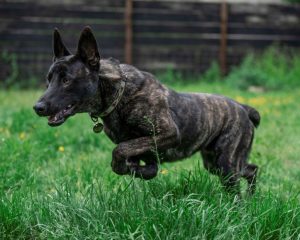 Body – The body is firm. The ribs are well-sprung. The chest is deep, but not narrow. The underline of the brisket flows gradually into the underline.
Body – The body is firm. The ribs are well-sprung. The chest is deep, but not narrow. The underline of the brisket flows gradually into the underline.
The short back is straight and powerful. The firm loins are neither long nor shallow. The croup is not short, nor does it slope excessively.
Hindquarters – The powerful, well-muscled hindquarters have good bone. Stifle angulation is normal, without exaggeration.
Hind Legs – The hock is moderately angled, enough so that the rear pastern is perpendicular to, or slightly less than, the ischium. There are no dewclaws on the hind legs.
Feet – The feet have well-arched, close-knit toes. The pads are firm and dark. The nails are black.
Tail – When at rest, the tail hangs straight or is gently curved, reaching to the level of the hock. When the dog is in action, the tail is carried gracefully upwards. It never curls up over the back nor falls sideways. Faults: Curled tail. Docked tail.
Coat – There are three distinct coat types.
Short Coat – The outer coat is rather hard, smooth, and close-lying all over the body A too-short coat is not desired. There is a woolly undercoat. A ruff, trousers, and feathered tail are clearly evident.
Long Coat – The long, sturdy hair is straight and close lying all over the body There are no curls or waves. There is a woolly undercoat. The head, ears, feet, and the hind legs below the hock are covered with short, dense hair. There is no feathering on the ears. The back of the forelegs are feathered, which gets shorter toward the feet. The tail is well-covered with long hair.
Rough Coat – The entire body is covered with a rough, harsh, tousled outer coat. There is a dense, woolly undercoat. The hair on the head forms eyebrows, which must be strong and off standing. The hair on the cheeks and ears is less strongly developed. Both the upper and lower lips must be well-covered with hair, forming a moustache and a beard. Well-developed trousers are preferred. The tail is abundantly feathered.
Colour – Must be brindle. Brindle is defined as a black or very dark streaked or striped effect, with hairs of a lighter background colour.
Very small white accents may occur on the breast and/or on the feet.
Short Coat & Long Coat – Brindle, on either brown or gray ground; and brindle all over the body, including the collar, trousers, or tail. A black mask is preferred.
Rough Coat – Brindle, on either brown or gray ground; and brindle all over the body, including the collar, trousers, or tail. A black mask is preferred. Compared to the other coat types, the brindle is less pronounced in the outer coat.
Faults (all coat types): Too much white on the breast. Too much white on the feet. Wrong colours. Mis-markings.
Serious Faults: White stripes or white spots on any part of the body other than the breast or feet.
Height – Height range for males is from 22½ to 24½ inches. Height range for females is from 21½ to 23½ inches.
Gait – Movement is smooth, supple, and normal. The legs are not brought forward in a tied way, neither floating not far-reaching.
Health Issues with the Dutch Shepherd
There are several conditions that we need to be aware of in the Dutch Shepherd. These include:
- Hip Dysplasia – While Hip Dysplasia has been recognised in the Dutch Shepherd, it is much less of an issue than it is in its close relative, the German Shepherd. Hip Dysplasia is a debilitating orthopaedic condition that leads to chronic osteoarthritis as an animal ages. It can be screened for with x-rays and affected animals should be removed from the breeding pool. This condition is thought to affect roughly 5-8% of the Dutch Shepherd population.
- Elbow Dysplasia – This is a condition that encompasses several abnormalities that can occur in the developing elbow. Affected dogs will show signs of discomfort and will often be lame on their front limbs. Imaging can diagnose the issue, and in some cases, surgery may be helpful. Around 3% of the population are thought to suffer from elbow dysplasia.
- Atopic Skin Disease – Allergic skin disease is one of the most common reasons a pet will be brought into a veterinary clinic for treatment. Affected dogs tend to suffer throughout their life with flare-ups of varying intensities. Itchy skin, rashes and watery eyes are all common symptoms. Several medications are available, each achieving mixed levels of success.
- Masticatory Myositis – An inflammation of the muscles near the mouth that leads to jaw pain and difficulty opening the mouth. Biopsies can confirm the condition, and it has a good prognosis if treated correctly.
- Pannus – This condition is more technically referred to as chronic superficial keratitis. A greyish-pink film may cover one or both eyes, and if left untreated, blindness will ensue. Lifelong medical treatment is usually required.
- Inflammatory Bowel Disease – When inflammatory cells infiltrate the gastrointestinal system, food is not properly digested, and dogs may vomit, develop diarrhoea, and lose weight. It can be a difficult condition to diagnose, and it will often take a long time to settle on a treatment plan, which will likely include lifelong medications and a diet change.
- Goniodysplasia – This is a very rare condition that has been reported in the wire-haired population of the Dutch Shepherd. It is not yet known if it is genetic, but screening tests should be performed in breeding animals. It will cause fluid to build up within the eye and may ultimately result in blindness.
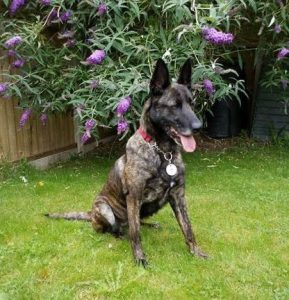 How Does a Dutch Shepherd Herder Differ from a German Shepherd Dog
How Does a Dutch Shepherd Herder Differ from a German Shepherd Dog
Besides both dogs being herding dogs, the Dutch Shepherd and the German Shepherd are also very active, loyal and intelligent canines. Both make great family dogs that also work well in the military, on police forces and as guide dogs. Their grooming needs are about the same (weekly brushing, more or less), but the GSD tends to shed more than the DSD. They have similar alert and responsive temperaments.
German Shepherds are larger than Dutch Shepherds, weighing about 20 pounds more, and GSDs have shorter life spans. Dutch Shepherd dogs have even higher energy levels than German Shepherds and need lots of exercise and activity. The German Shepherd is a little bit easier to train because it is more eager to please than the independently minded Dutch Shepherd. Finally, they do not have the same health concerns; German Shepherds have been extensively overbred and are notorious for hip dysplasia. While the Dutch Shepherd is not immune to health issues, it is not as prone to genetic problems as the GSD.
Herder bundle of energy
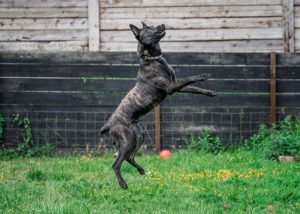 There are so many Shepherds out there to choose from: Dutch, German, Belgian, Dax, and more. All of them have special qualities. While you may be better acquainted with its cousins, the German Shepherd and the Belgian Shepherd, the Dutch Shepherd is an all-round amazing dog that is a great fit for any active family. This is a super intelligent dog that owns the ring when it comes to obedience competitions, guard duty, and field/agility trailing.
There are so many Shepherds out there to choose from: Dutch, German, Belgian, Dax, and more. All of them have special qualities. While you may be better acquainted with its cousins, the German Shepherd and the Belgian Shepherd, the Dutch Shepherd is an all-round amazing dog that is a great fit for any active family. This is a super intelligent dog that owns the ring when it comes to obedience competitions, guard duty, and field/agility trailing.
Even though the Dutch Shepherd made its debut on the farm, this breed now makes a wonderful companion for your family. Obedient and smart, this dog is a pleasure to train and will watch over your family. And because he is loving and playful, kids will always have a pal to play with. He will fit in well to just about every home, provided that you have the space and energy necessary to keep him happy!